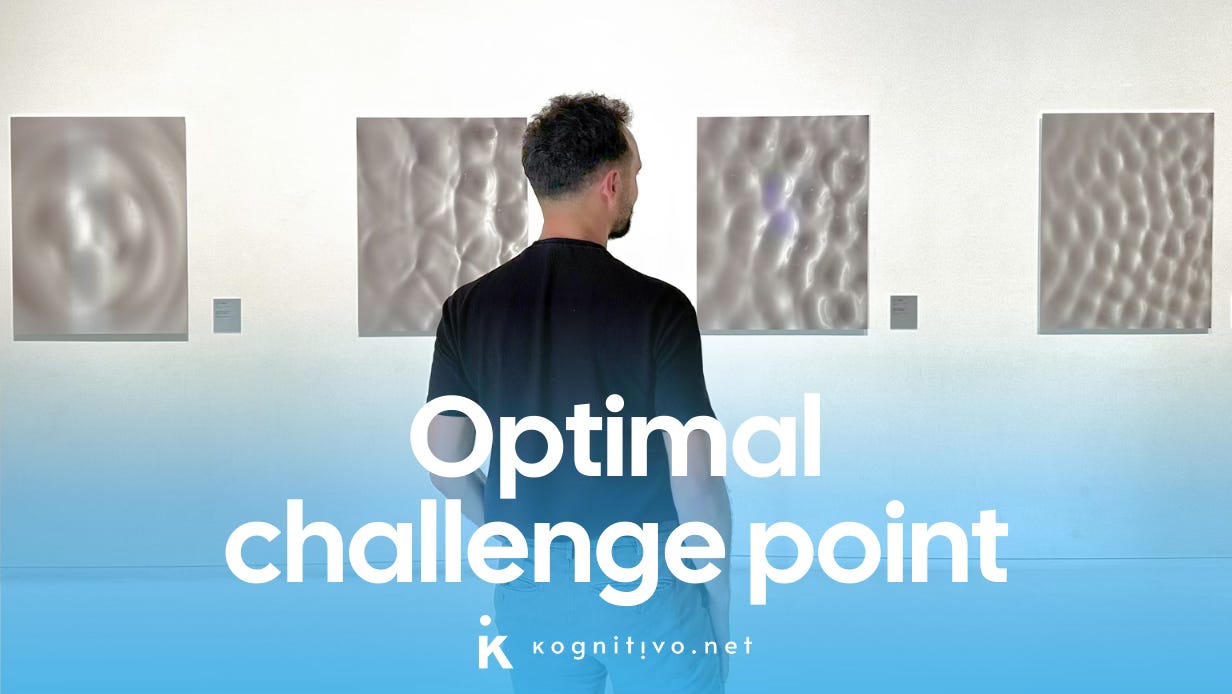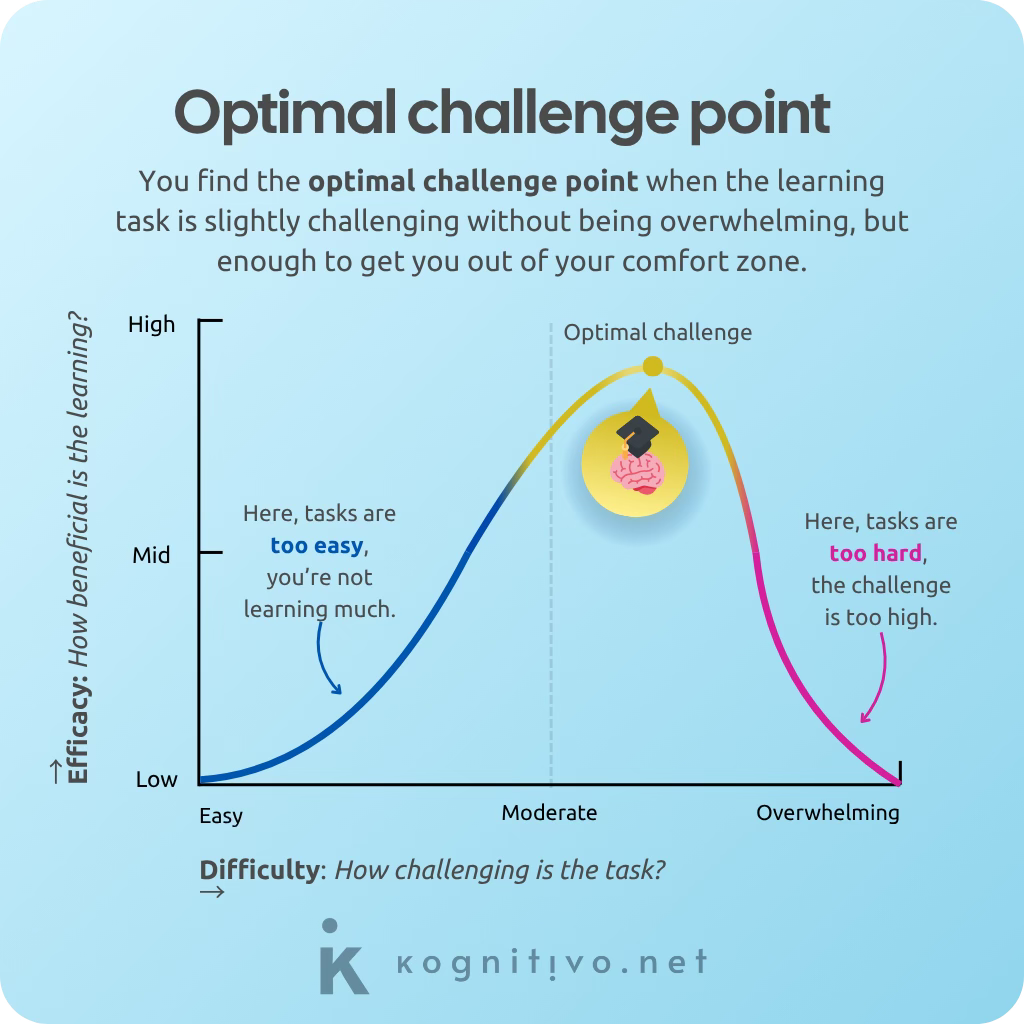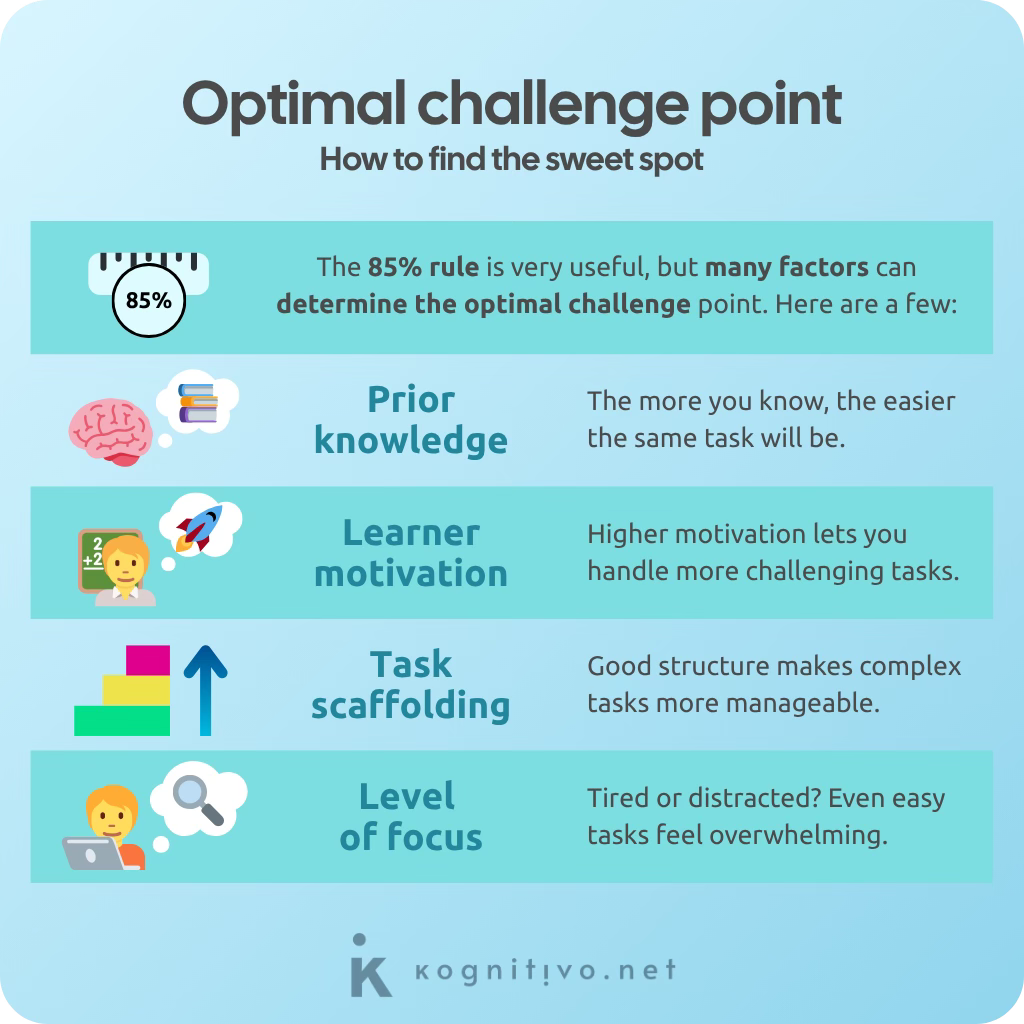Optimal challenge point: how hard should learning be?
We often wonder about the best learning methods, but what about the intensity? Not too easy, not too hard... so how hard is hard enough? Let’s explore optimal challenge.
Last week's article was about desirable difficulties: the kinds of challenges that boost your learning (because not every difficulty is desirable). But there’s another key question we haven't tackled yet: not just what kind of difficulties we should aim for, but how difficult they should be (their intensity).
So, how hard is hard enough?
Many of us struggle to adjust the difficulty of our learning tasks. Trying to read a novel in a foreign language before you’ve mastered basic grammar probably isn’t a winning strategy. But I’ve yet to meet anyone who became fluent by sticking to Duolingo alone. Finding the right level of challenge isn’t obvious.
But here’s what most people don’t know.
When scientists analyzed how fast learning happens under specific conditions, they discovered something striking: the golden zone is where you’re right about 85 percent of the time and wrong 15 percent.
In that range, they observed that learning accelerated. If learners drifted into harder territory (more errors) or easier territory (fewer errors), progress slowed. In other words, how often you get stuff right is a decent clue for the optimal difficulty of a task.
What is the optimal challenge point?
That 85 percent success rate isn’t just a curiosity. It points to a deeper principle known as the optimal challenge point.
The optimal challenge point is a concept from cognitive science which defines the level of task difficulty that leads to the most effective learning. It sits between two extremes: tasks that are too easy, which encourage repetition without growth, and tasks that are too difficult, which lead to disengagement or non-constructive failure.
At the optimal challenge point, learners operate just beyond their current level of mastery. Success is possible, but effortful. Errors are frequent enough to trigger adaptation, but not so frequent that they become discouraging. The result is what researchers call productive struggle, a state where attention, memory and motivation are all engaged.
The term comes from motor learning research, particularly the work of Guadagnoli and Lee (2004), who showed that learning is most effective when task difficulty is a little harder than the learner’s current skill level. While originally applied to physical performance, the same principle holds across domains: from language learning to math, from music to memory.
This framework also echoes a classic learning theory: the zone of proximal development. Lev Vygotsky argued that the area where you can grow further next (or your “zone of proximal development”) is just beyond what you can do without support. The overlap is clear: both models point to a narrow window of optimal challenge, just past your comfort zone.
How to find the sweet spot
There’s no universal formula for hitting the optimal challenge point. But there are signs that you’re in the right zone.
The first guideline you can safely use is the accuracy rate of your answers. The 85% principle is a great reference, as it's backed by scientific evidence. However, consider that it was tested with specific kinds of tasks: direct (yes/no answers), with clear feedback (after each trial) and with incremental progress (such as categorizing or language drills). It might not be 100% applicable to all types of practice.
The truth is, the optimal challenge point varies significantly from learner to learner. A task that stretches one learner might overwhelm another.
Prior knowledge is the single biggest factor in determining the right level of difficulty. The more mental models you’ve built, the less working memory a task demands, and the more cognitive space you have to engage with new material.
Other variables matter too. A motivated learner can handle more complexity (like you, am I right?). A well-scaffolded task (i.e., one that starts easy and becomes more difficult step by step) lowers the difficulty without dumbing things down. Even your level of focus or fatigue shifts where the “just hard enough” line falls.
Use it wisely
The idea of the optimal challenge is a qualitative framework backed by empirical data, but unlike other theories in cognitive science (such as cognitive load theory), it’s hard to quantify universally. Think of it as a guiding principle, not a precise formula.
And remember: the kind of difficulty matters too. If the challenge isn’t desirable, there’s no optimal point… just wasted effort. You’ve heard “work smarter, not harder”? Try this instead: work smarter and harder... enough.
By the way, you might not be at the optimal challenge point just now, but you’re definitely at the optimal subscribe point. So, go ahead: it only gets better (harder) from here.
Keep learning
Nerd out with AI
Prompt suggestions. Always ask follow-up questions
Act as a coach. I want to apply the idea of the optimal challenge point to a skill I'm learning. Can you help me design a practice routine that keeps me in the right difficulty zone?
I’ve just read an article on the topic of “difficulty in learning”. I’ve always thought that making learning easier and more accessible was the point of good education. Let’s discuss this topic: provide arguments supporting the idea of making learning strategically harder.
Act as a teacher and test me using retrieval practice on the concept of the optimal challenge point. Ask me 5 questions, one at a time, only proceeding when I answer each one. Make them progressively harder.
Links
📄 The eighty-five percent rule for optimal learning: This article explains the research findings on the 85% rule. As mentioned, it focuses on “binary classification tasks”, where feedback is immediate, and tasks require one of two responses. This may or may not fully apply to the kind of practice you need, but in any case, it’s an invaluable reference!
📑 Challenge point: A framework for conceptualizing the effects of various practice conditions in motor learning: You can download here the paper where the idea of “optimal challenge point” appeared for the first time. The graph shown in this article is a simplified version of one from the original paper.
The cover photo includes some artworks from the series “milch” (2000) by Carsten Nicolai, 21st century museum (Kanazawa).
This article was shorter than usual.
Did you enjoy it?
Let me know in the comments!






"How hard is had enough", "How good is good enough" I enjoyed your post very much, and the issue of "learning difficulty" is so important for every teacher, coach, trainer and the like. I guess that some of them, I mean those who teach, coach or train others, know this intuitively, others should learn it. Thank you very much Javier for your article 👏